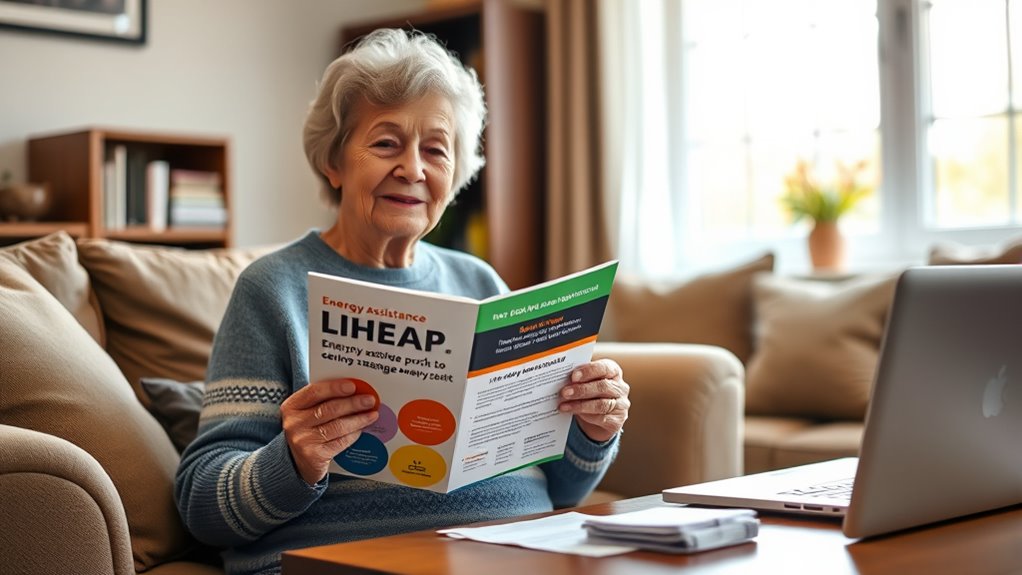To help manage energy bills, you can apply for programs like LIHEAP, which provides financial assistance for heating and cooling costs based on your household income. Many states and utility companies also offer additional support, such as discounts or payment plans. Taking advantage of energy-saving tips and early program enrollment can prevent bill spikes and disconnection. If you want to discover more ways to keep your home comfortable and affordable, keep exploring your options.
Key Takeaways
- LIHEAP offers direct financial assistance to seniors for heating and cooling costs based on income and household size.
- Many states and utility companies provide additional programs like discounts, payment plans, and emergency relief options for seniors.
- Energy-saving practices such as sealing drafts and using programmable thermostats help reduce utility bills for older adults.
- Early application for assistance programs prevents disconnection and helps seniors manage rising energy costs effectively.
- Local agencies and community organizations can guide seniors through application processes and available support options.

As energy bills continue to rise, many seniors find it challenging to keep their homes warm without financial strain. Rising costs can quickly eat into a fixed income, making it difficult to balance utility payments with other essential expenses. Fortunately, there are programs designed to provide utility assistance, helping seniors manage their energy bills more effectively. These programs aim to ease financial burdens and support older adults in maintaining a safe, comfortable home.
Rising energy costs make it hard for seniors to keep homes warm; assistance programs can provide critical support.
One of the most well-known programs is the Low Income Home Energy Assistance Program (LIHEAP). LIHEAP offers direct financial aid to help cover heating and cooling costs. Eligibility is based on income and household size, ensuring that those who need it most receive support. If you qualify, LIHEAP can make a significant difference by reducing your monthly utility bills. Applying is straightforward, and many local agencies assist seniors through the application process, taking some of the stress out of managing your energy expenses.
In addition to LIHEAP, some states and utility companies offer their own assistance programs. These may include discounts, payment plans, or emergency relief funds. By exploring these options, you can find tailored support that fits your specific needs. Many utilities also promote budget management strategies, encouraging you to adopt energy-saving habits and monitor usage carefully. Simple steps like sealing drafts, using programmable thermostats, and replacing inefficient appliances can lower your energy consumption and reduce bills over time.
Understanding how to manage your budget is essential when facing rising utility costs. Creating a detailed household budget helps you track income and expenses, highlighting areas where you can cut back. When you know exactly how much you spend on energy each month, you’re better positioned to identify opportunities for savings and to plan for upcoming bills. Additionally, increasing awareness of energy-efficient practices can further help reduce your overall costs. For example, utilizing energy-saving tips can significantly impact your monthly payments. If you’re unfamiliar with available energy assistance programs, reaching out to local agencies can provide valuable guidance and support. Furthermore, exploring sustainable energy options might offer long-term solutions to lower your bills and reduce your environmental impact.
It’s important to reach out early if you’re struggling with energy bills. Don’t wait until the situation becomes urgent. Applying for utility assistance programs can provide immediate relief and help you avoid disconnection or late fees. Additionally, many programs prioritize seniors, recognizing the unique challenges you face. By taking advantage of these resources, you’re not only reducing your current bills but also gaining tools to better manage your household expenses in the future. Knowing about financial assistance options can empower you to make informed decisions and secure necessary support.
Frequently Asked Questions
Are There Income Eligibility Requirements for Energy Assistance Programs?
You’ll need to meet income verification standards to qualify for energy assistance programs. These programs have specific program income limits, which vary by location and household size. When you apply, you’ll provide documents to verify your income, ensuring you meet the eligibility criteria. If your income falls within the program limits, you could receive assistance to help manage your energy bills. Always check local requirements for the most accurate information.
Can Seniors Apply for These Programs if They Rent Rather Than Own?
Hold your horses, this isn’t the Wild West! Yes, seniors who rent can often qualify for energy assistance programs. Rental assistance and senior eligibility criteria vary by program, but many offer support regardless of homeownership. You’ll want to check specific program rules to see if your income and rental status qualify. Don’t saddle yourself with high bills—these programs are designed to lend a helping hand.
How Do I Apply for LIHEAP and Similar Assistance Programs?
To apply for an energy assistance program like Liheap, start by gathering your documents and visiting the official website or local agency. Fill out the energy assistance application accurately, providing details about your income and household. Make certain you meet the program eligibility requirements, which often include income limits and residency status. Once submitted, follow up to guarantee your application is processed promptly and receive support to help with your energy bills.
Are There Any Programs Specifically for Seniors With Disabilities?
You can find programs specifically for seniors with disabilities that offer disability accommodations and accessible application processes. These programs aim to make applying easier by providing support like assistance with paperwork or alternative formats. To access these benefits, contact local agencies or visit their websites, where you’ll find tailored resources designed to meet your needs. Don’t hesitate to ask about disability accommodations to guarantee the application process is smooth and accessible for you.
What Documents Are Needed to Verify Eligibility for Energy Assistance?
Verifying your eligibility is like assembling a puzzle—you need the right pieces. Usually, you’ll need verification documents such as proof of income, ID, and utility bills. Fill out application forms carefully, providing accurate details. Make sure to gather all required documents before applying to avoid delays. Contact your local assistance program to confirm specific requirements, as they may vary by location. This way, you’ll streamline the process and get the help you need.
Conclusion
Remember, while programs like LIHEAP can ease your energy bill worries, they’re just one part of your overall well-being. Facing high bills might seem overwhelming, but these resources offer relief and hope. Don’t wait until it’s too late—reach out now and take control of your energy costs. Because in life, just like in energy bills, a little help can make all the difference between struggle and stability.









